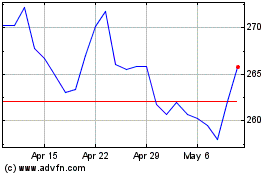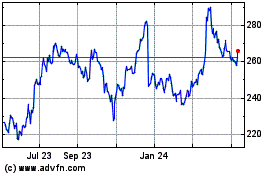FedEx, UPS Gear Up for Holiday Orders
September 30 2016 - 10:50AM
Dow Jones News
Holiday hiring is expected to be flat at package-delivery giants
FedEx Corp. and United Parcel Service Inc., but that masks efforts
behind the scenes to prepare for the coming wave of e-commerce
orders.
FedEx is opening four new hubs and "dozens" of small, satellite
facilities to receive, sort and ship an expected surge in packages
between Thanksgiving and Christmas, executives said this week. UPS
is expanding a network of temporary sorting hubs and is increasing
its use of software to help sort packages faster, a spokeswoman
said.
Both companies have also invested in automation so they can
process more packages over the holidays while keeping staffing
levels relatively steady. If their projections hold, FedEx and UPS
will have kept the number of seasonal workers steady for two years
running, at over 50,000 and 95,000 workers respectively, after
sharply ramping up holiday hiring earlier in the decade.
"We've been able to hold the line and sustain the number of
seasonal workers" despite having more volume, said Susan Rosenberg,
a UPS spokeswoman.
Many of FedEx's new facilities will have automation technology
that moves and scans packages at a faster pace, which helps offset
its reliance on hard-to-find seasonal workers, said Raj
Subramaniam, an executive vice president at FedEx. The company saw
volumes reach 25 million shipments in a day three times during the
peak holiday period last year, he said. The Memphis, Tenn., company
ultimately kept on seasonal workers into 2016 because of growing
e-commerce demand throughout the year.
FedEx spokesman Glen Brandow said the projected holiday hiring
number could grow, and said there is no link between the company's
technology and its flat projection.
The automated satellite facilities also bring more FedEx
services closer to its retail customers, said Satish Jindel,
president of tracking software developer ShipMatrix Inc. FedEx is
"realigning the network for the new e-commerce world…They are
recognizing that the world of parcel has changed as a result of
rapid growth of online retail," he said.
UPS's additional "mobile delivery centers," first introduced in
2014, are often built in clusters and are located near population
centers where e-commerce is growing quickly. They can be activated
to help the Atlanta-based carrier handle the peak rush without
further increasing seasonal hires, and deactivated when they aren't
needed, Ms. Rosenberg said.
UPS is also increasing its use of technology. Instead of
memorizing zip codes, software and automation technology help route
packages, reducing training time and increasing accuracy. The
system also enables UPS to more easily workers between different
tasks and units.
The changes come as logistics and transportation companies are
dealing with the increased complexity and higher costs of
fulfilling online orders, which have to be collected, sorted, then
sent out to widely scattered addresses in shorter windows of time.
As shoppers grow more accustomed to last-minute gift orders, FedEx
and UPS, as well as retailers and their other logistics providers,
have struggled in recent years to deliver so many packages in time
for the holidays.
Adding to the complexity, U.S. consumers are also increasingly
buying oversized items online, such as exercise bicycles and
mattresses, which require manual handling because they cannot be
fed onto conveyor belts in automated facilities along with smaller
packages.
FedEx and UPS have both raised prices for delivering large
packages, and FedEx is allocating separate space at six of its
facilities this year to sort and ship the bulky items, an attempt
to prevent surging volumes of appliances and furniture from gumming
up the works at its main sorting centers. In total, FedEx expects
capital spending for its current fiscal year to reach $5.6 billion,
up from $4.8 billion last year.
FedEx and UPS collectively make up 40% to 45% of deliveries,
with the U.S. Postal Service making up most of the rest of the
market, according to Shipmatrix.
Mike Esterl contributed to this article
Write to Loretta Chao at loretta.chao@wsj.com
(END) Dow Jones Newswires
September 30, 2016 10:35 ET (14:35 GMT)
Copyright (c) 2016 Dow Jones & Company, Inc.
FedEx (NYSE:FDX)
Historical Stock Chart
From Mar 2024 to Apr 2024

FedEx (NYSE:FDX)
Historical Stock Chart
From Apr 2023 to Apr 2024
